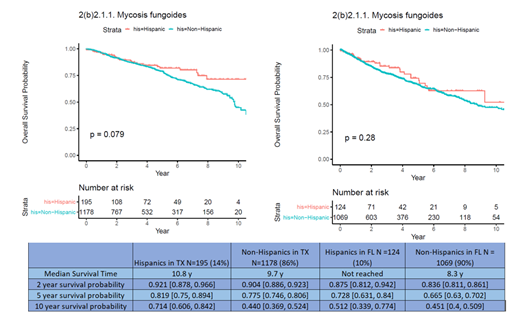Abstract
Introduction
Cutaneous T cell lymphomas (CTCLs) are a heterogeneous group of extra-nodal non-Hodgkin's lymphomas that are characterized by a cutaneous infiltration of malignant monoclonal T lymphocytes (F1000Res. PMID 27540476). Among them, Mycosis Fungoides (MF) is the most predominant subtype, accounting for 50-65% of cases (An Bras Dermatol. PMID 30066762). Although most patients with MF are Non-Hispanic (NH), from the 1970s to 2010s there has been an increase in the percentage of HI patients (4% to 11%, respectively) (J Eur Acad Dermatol Venereol. PMID 32141115). Racial disparities in MF have been studied, but they are still poorly understood in Hispanic (HI) populations and further studies are needed to evaluate the role of ethnicity in MF outcomes. In this study, we focused on two communities, Texas (TX) and Florida (FL), which have a strong HI representation. According to the U.S 2020 Census, 39% of the population of TX and 26% of the population of FL are HI. Therefore, the purpose of this study is to compare demographics, treatment patterns, and survival outcomes of HI and NH patients diagnosed with MF, and to contrast HI cohorts between TX and FL.
Methods
This is a retrospective analysis of patients diagnosed and recorded in the Texas Cancer Registry and the Florida Cancer Data System from years (y) 2006-2017. Inclusion criteria was histopathologic proven MF. Patients were divided into HI and NH for comparison. Standard demographic, socioeconomic, clinical, and survival variables were reviewed. All statistical testing was determined using Fisher's Exact test, Pearson's Chi-square test, T-test or Wilcoxon test, as appropriate. Survival time was measured using the day of diagnosis to last date of follow up or death. Survival distribution were calculated based on Kaplan-Meier curves. All statistical testing was two-sided with a significance level of 5%.
Results
We identified a total 2566 (1373 TX, 1193 FL) patients with MF. 319 (12%) were HI and 2247 (88%) were NH. The median age of diagnosis in our TX population was 50 y in HI and 59 y in NH (p < 0.001). In FL, the median age of diagnosis was 57 y in HI and 65 y in NH (p <0.001). There was a statistically significant difference in poverty index between HI and NH in both TX and FL. The majority of HI (42%) in TX were in the 20-100% bracket while the majority of NH (28%) in TX were in the 10-19.9% bracket (p<0.001). In contrast, the majority of HI (36%) in FL were in the 10-19.9% bracket while the majority of NH (34%) in FL were also in the 10-19.9% bracket (p<0.001). In patient where insurance status was known, there was a statistically significant difference in insurance status with the most frequent insurance being private insurance for HI in TX (28%) and NH in TX (24%) (p<0.001). In FL, HI (39%) had private insurance whereas NH (30%) had government-sponsored insurance (p<0.001). The most common stage at diagnosis in both cohorts in TX and FL was Stage I with 56% HI in TX vs 56% NH in TX (p=0.526) and 54% HI in FL vs 44% NH in FL (p=0.052). In both cohorts, majority of HI (71%) in TX, and NH (72%) in TX (p=0.38), HI (73%) in FL and NH (81%) (p=0.156) did not undergo chemotherapy. In TX, median survival (MS) was 10.8 y for HI, and 9.7y for NH; whereas in FL, MS was not reached for HI, and for NH was 8.3y. The survival probability at 2 y was 0.921, 0.904, 0.875, 0.836 for HI in TX, NH in TX, HI in FL, and NH in FL, respectively. The survival probability at 5 y was 0.819, 0.775, 0.728, 0.665 for HI in TX, NH in TX, HI in FL, and NH in FL, respectively. The survival probability at 10 y was 0.714, 0.440, 0.512, 0.451 for HI in TX, NH in TX, HI in FL, and NH in FL, respectively. There was no statistically significant difference in overall survival (OS) probability between HI and NH in TX (p = 0.079) and FL (p = 0.28).
Conclusions
In this study, we evaluated ethnic disparities in MF, we chose to study TX and FL, two states that have a strong HI representation. In both populations, we found a statistically significant difference between HI and NH in poverty index and insurance status. Although there were no statistically significant differences in median survival time or survival probability at 2, 5, and 10 y among the HI and NH cohorts within each state, we observed that NH and HI in FL had a lower survival probability at 2, 5, and 10 y when compared to NH and HI in TX. Moreover, NH in TX had a much lower OS probability when compared to HI. These disparities may be a direct reflection of the significantly higher rates of poverty among HI in FL compared to HI in TX.
Diaz Duque: Incyte: Consultancy; Morphosys: Speakers Bureau; Astra Zeneca: Research Funding; Hutchinson Pharmaceuticals: Research Funding; Epizyme: Consultancy; ADCT: Consultancy.


This feature is available to Subscribers Only
Sign In or Create an Account Close Modal